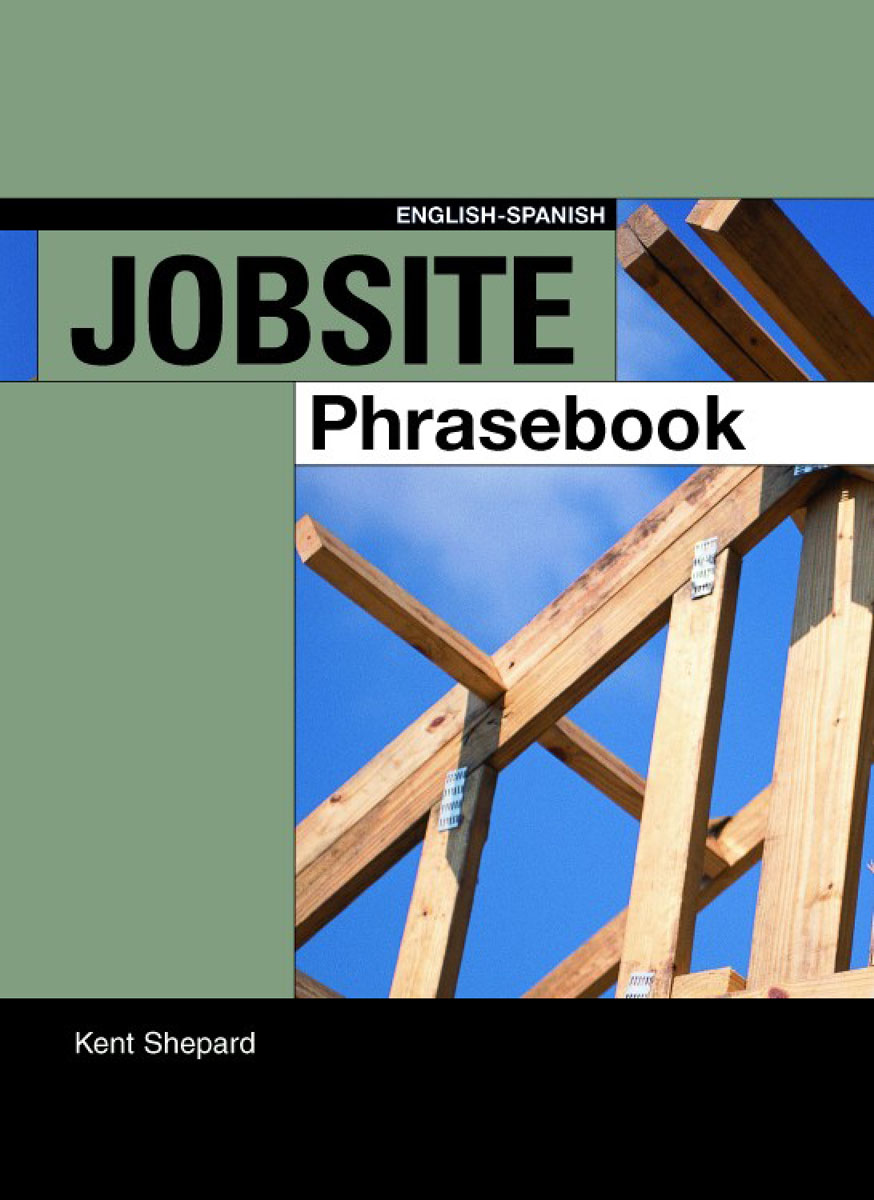 Jobsite Phrasebook BuilderBooks, a Service of the National Association of Home Builders
Jobsite Phrasebook BuilderBooks, a Service of the National Association of Home Builders
| Courtenay S. Brown | Director of Book Publishing |
| Doris M. Tennyson | Senior Editor |
| Natalie C. Holmes | Editor |
| Torrie Singletary | Production Editor |
| Karel Leon | Spanish Proofreader |
| E Design Communications | Cover Design |
| McNaughton-Gunn, Inc. | Printing |
| Gerald M. Howard | NAHB Executive Vice President and CEO |
| Mark Pursell | NAHB Senior Staff Vice President. Marketing & Sales Croup |
| Lakisha Campbell | NAHB Staff Vice President, Publication & Affinity Programs |
Disclaimer This publication provides accurate information on the subject matter covered. The publisher is selling it with the understanding that the publisher is not providing legal, accounting, or other professional service. If you need legal advice or other expert assistance, obtain the services of a qualified professional experienced in the subject matter involved. Reference herein to any specific commercial products, process, or service by trade name, trademark, manufacturer, or otherwise does not necessarily constitute or imply its endorsement, recommendation, or favored status by the National Association of Home Builders. The views and opinions of the author expressed in this publication do not necessarily state or reflect those of the National Association of Home Builders, and they shall not be used to advertise or endorse a product. 2003 by BuilderBooks.
All rights reserved. No part of this book may be reproduced or utilized in any form or by any means, electronic or mechanical, including photocopying and recording or by any information storage and retrieval system without permission in writing from the publisher. Printed in the United States of America 11 10 09 083 4 5 eISBN-13 978-0-86718-710-6 Library of Congress Cataloging-in-Publication Data Jobsite phrasebook.-- English-Spanish. p. cm. ISBN-10 0-86718-538-4 (pbk) ISBN-13 978-0-86718-538-6 1.
Building--Terminology. 2. English language--Terms and phrases--Spanish. 3. Spanish language--Terms and phrases--English. I.
National Association of Home Builders (U.S.) TH9.J575 2002 690.014--dc21 2002154928 For further information, please contact:  National Association of Home Builders 1201 15th Street, NW Washington, DC 20005-2800 800-223-2665 Visit us online at www.BuilderBooks.com.
National Association of Home Builders 1201 15th Street, NW Washington, DC 20005-2800 800-223-2665 Visit us online at www.BuilderBooks.com.
ABOUT THE AUTHOR
After moving from Colorado to Southern California in the early 1970s, Kent Shepard spent 30 years working as a tradesman and contractor on residential and light commercial projects. These included housing tracts of up to 200 homes, custom homes up to 17,000 square feet, apartment complexes to 1200 units, hotels (look at the octagon and dome on the roof of the Hotel California CD by the Eagles), and a wide variety of remodeling projects. Living again in Colorado near the continental divide, Kent has worked as a framing and finish carpenter, Home Inspector and framing and remodel contractor. He pursues a variety of interests including operating a home inspection and snow removal businesses, photography, etching sandstone, mushroom hunting, skeletal rearticulation (an ostrich project currently in progress), and fatherhood. Kent is aided in the latter-most endeavor by his son Hunter and daughter Christina.
Other books by Kent Shepard are Concrete Jobsite Phrasebook and Framing Jobsite Phrasebook, also published by BuilderBooks.com.
ACKNOWLEDGMENTS
I would like to thank, first of all, Theresa Minch and Jessica Poppe from BuilderBooks for their efforts, which were key in bringing a ten-year project to fruition. Also Christine Charlip, Torrie Singletary, and Karel Leon for help with the 1st reprint. My son Hunter helped with the manuscript, and along with my daughter Christina, put up with me while the work was in progress. Thanks also to Ryan Kramer, my twelve-year-old neighbor who, when my computer became infected with a virus and crashed a few weeks before the final deadline, rescued the files.
CONTENTS
ILLUSTRATIONS
PRONUNCIATION
Jobsite Phrasebook uses a simplified method of phrase pronunciation in which the syllable stressed is capitalized.
CONTENTS
ILLUSTRATIONS
PRONUNCIATION
Jobsite Phrasebook uses a simplified method of phrase pronunciation in which the syllable stressed is capitalized.
Although a close study of the rules of Spanish grammar is beyond the scope of this book, the following short study should be of some service. VOWELS:
| a | Always an ah sound as in mama and mambo |
| e | Always a long a sound as in they and prey |
| i | Always a long e sound as in police and piece |
| o | Always a long o sound as in oak and old |
| u | Always a long u sound as in chute or tube |
CONSONANTS: Pronounced as in English: b, ch, d, f, h, k, l, m, n, p, s, and t
| c | Sounds like k as in can and could |
| g | Sounds hard like gain and go except before i and e when it is soft like h in hit or hey |
| j | Sounds like h as in hard and hello |
| ll | Sounds like y as in yes and yard |
| n | Pronounced as in English |
| Sounds like ny and in canyon. This n should have an accent mark above it |
| qu | Sounds like k as in quiet and quality |
| r | Pronounced as in English except after n, l, or s at the beginning of a word, when it is rolled (shown by three rs in the text pronunciation as in rrroll) |
| rr | Is always rolled |
| v | Sound like b as in banana or bill |
| w | Seldom used |
| x | Pronounced as in English |
| y | Prounced as in the English yes and yard, except where it stands alone, when it is pronounced as a long e |
| z | Prounced as the English s |
NOUNS: Nouns are slightly more complicated and you dont have to know this section to use this book effectively. In Spanish, nouns are divided into masculine and feminine and generally follow these rules.
MASCULINE NOUNS:- The names of male beings (men, uncles, kings).
- Words ending in o
- Days of the week, months, rivers, oceans and mountains.
- Nounds ending in l, r, or ma
FEMININE NOUNS:- Names of female beings (women, aunts, queens).
- Nouns ending in a
- Nouns ending in in, d, z or umbre
VERBS: Frequently throughout
Jobsite Phrasebook the infinitive imperative form of the verb is used for the sake of directness and clarity, and also to avoid problems of propriety in terms of both the singular familiar and polite verb forms denoting you, which in Spanish can be done.
Next page
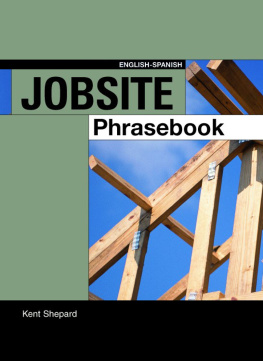


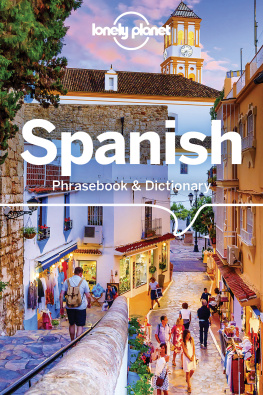
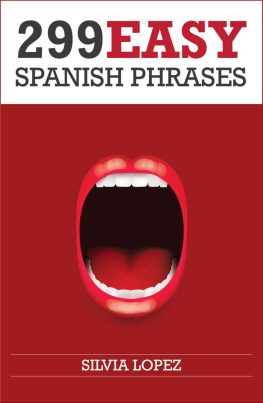
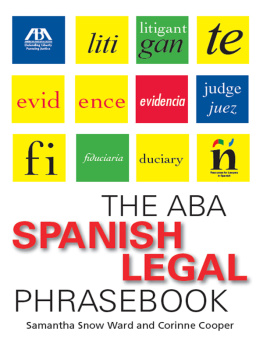
 Jobsite Phrasebook BuilderBooks, a Service of the National Association of Home Builders
Jobsite Phrasebook BuilderBooks, a Service of the National Association of Home Builders National Association of Home Builders 1201 15th Street, NW Washington, DC 20005-2800 800-223-2665 Visit us online at www.BuilderBooks.com.
National Association of Home Builders 1201 15th Street, NW Washington, DC 20005-2800 800-223-2665 Visit us online at www.BuilderBooks.com.